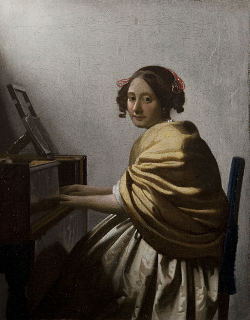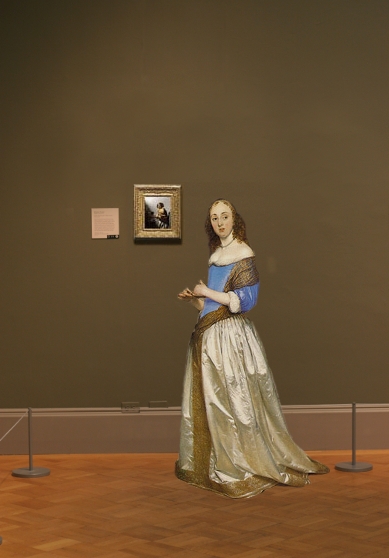A Young Woman Seated at the Virginal
(questionable)Oil on canvas
c. 1670
25.2 x 20 cm. (9 7/8 x 7 7/8 in.)
The Leiden Collection, New York
inv. JVe-100
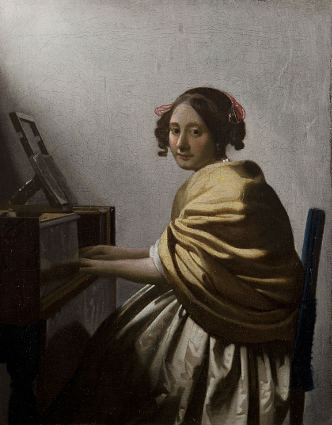
The textual material contained in the Essential Vermeer Interactive Catalogue would fill a hefty-sized book, and is enhanced by more than 1,000 corollary images. In order to use the catalogue most advantageously:
1. Scroll your mouse over the painting to a point of particular interest. Relative information and images will slide into the box located to the right of the painting. To fix and scroll the slide-in information, single click on area of interest. To release the slide-in information, single-click the "dismiss" buttton and continue exploring.
2. To access Special Topics and Fact Sheet information and accessory images, single-click any list item. To release slide-in information, click on any list item and continue exploring.
The strangely painted arms of the seated musician
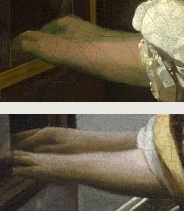
In order to bolster the legitimacy of the present work, critics have emphasized the striking similarity in the unusual treatment of the musician's arms to those in A Lady Seated at a Virginal (London), despite the fact that neither instance is among the finest examples of Vermeer's painting technique. Some critics argue that the arms of A Lady Seated at a Virginal—Albert Blankert referred to them as "pig's trotters"—indicate the artist's waning artistic abilities.
Conversely, Lawrence Gowing regarded the London arms not as a flaw but as the outcome of the artist's commitment to what he termed the "optical way," in which the artist remains faithful to what his eye truly observes rather than what the mind understands, although he called the picture a "melancholy relic."Gowing points to the distorted hand, almost unrecognizable from an anatomical standpoint, of the seated artist in The Art of Painting as an example of Vermeer's distinctive style.
The yellow shawl
Although the shawl of the young girl is created with pigments characteristic of Vermeer's palette (the base yellow is lead-tin yellow), it is generally deemed inadequate in reflecting his exceptional technique and mastery of chiaroscuro modeling. Neither its fabric—some perceive it as wool, while others see it as satin—nor the cumbersome folds are entirely comprehensible. Likewise, similar garments are not depicted in domestic interior paintings of that era.
Vermeer expert Arthur K. Wheelock Jr., who once questioned the work's authenticity, now believes that while Vermeer did create the painting, the shawl was added by a subsequent hand to complete the figure in an atypical way. He posits that the current work and Girl with a Flute were sold soon after the artist's passing and were finalized by another artist to enhance their marketability.
Lead-tin yellow was prevalent from the Middle Ages until the late 17th century but became obsolete thereafter, supplanted by other shades like yellow ochre and Naples yellow. Indeed, awareness of this pigment faded over time, and it was only in 1941 that a scientist realized the presence of a tin component in this distinct 17th-century yellow, setting it apart from later, lead-based yellows. The fact that lead-tin yellow was the principal pigment used for the yellow shawl suggests that the painting may be a 17th-century work and not, as some have posited, a later imitation of Vermeer's style.
The face the girl
Rembrandt or Gerrit ter Borch, the depiction of this girl's face falls short even by his own standards. Her melancholic smile and somewhat unfocused gaze lack the finesse and technical vitality evident in the similar girl featured in the later work A Lady Seated at a Virginal, which was painted around the same time.
The hairstyle and falling lock, fashionable for only a limited period, closely resemble those in The Lacemaker and help establish the painting's date. The fine red ribbons may be original, but they were strengthened during the painting's restoration.
The expert committee of art specialists that confirmed the painting's authenticity discovered that the shadows on the girl's face contain green earth, a rather mundane green pigment used only infrequently by 17th-century Dutch artists in flesh tones. Surprisingly, this pigment is found in some of Vermeer's later works.
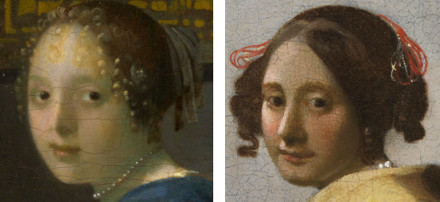
By the 17th century, green earth, once a foundational component of medieval flesh tones, had been largely replaced by warmer brown earth pigments. Its use seems to have been limited to European Mannerist schools and, in the Netherlands, to the Utrecht school. Interestingly, Vermeer's mother-in-law, Maria Thins, was distantly related to Abraham Bloemaert, who educated a generation of Utrecht's finest artists, including the gifted Hendrick Terbrugghen. Bloemaert had earlier affiliations with the Haarlem mannerists. Moreover, Maria Thins owned a notable collection of works by Utrecht artists, some of which appear in Vermeer's paintings as background elements.
While a plausible source can be identified, no persuasive explanation has yet been offered for why Vermeer chose to employ this antiquated technique.
Ultramarine mixed into the background wall gray
According to the technical analysis conducted by a special committee to study the authenticity of the current work, tell-tale signs of ultramarine blue were found in the light gray mixture used to paint the background wall. Vermeer is well-known for using this pigment extensively, not only for blue objects but also to lighten the light gray tones of his background walls. The blue tends to counterbalance the flat, "aircraft gray" produced by the basic mixture of white and black pigments.
The subtle effect of natural ultramarine in such small quantities is difficult to quantify, but Vermeer clearly believed it was essential for achieving the effects he sought. In this painting, ultramarine was found not only in the blue velvet chair back but also in the background wall.
However, it should be noted that none of Vermeer's later works, including The Lacemaker, The Guitar Player and The Geographer, in which the pigment of the background walls has been tested, contain ultramarine.
The satin gown
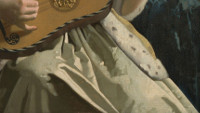
The Guitar Player (detail)
Johannes Vermeer
c. 1670–1673
Oil on canvas, 53 x 46.3 cm.
Iveagh Bequest, London
The best passage in this work is generally considered to be the satin gown, even though it lacks the boldness and geometrical qualities of a similar gown depicted in Vermeer's Guitar Player. Also present are the dots, dabs and calligraphic flourishes that appear unrelated to description.
The virginal
The virginal and its music stand are similar, but not identical, to those in two confirmed works by Vermeer: A Lady Standing at a Virginal and A Lady Seated at a Virginal in London. However, the authentic works by Vermeer are far more sophisticated in both composition and narrative.
The modesty of the present work might conceivably suggest that it was conceived as a preparatory study for A Lady Seated at a Virginal in London, or perhaps for a contained, single-figure composition such as The Lacemaker. However, oil studies rarely, if ever, occur in 17th-century Dutch interiors and are completely absent from Vermeer's oeuvre. Moreover, The Lacemaker is far more sophisticated in both composition and technique.
The Chair
special topics
- Recent critical acceptance
- One of Vermeer's last paintings
- The virginal in Dutch interior painting
- A portrait?
- The artist's final hardships
- Vermeer's limited fame
- Listen to period virginal music
Is A Young Woman Seated at the Virginals an authentic painting by Johannes Vermeer?
The signature
No signature appears on this work.
Dates
c. 1670–1672
Walter Liedtke, Vermeer: The Complete Paintings, New York, 2008
c. 1670–1671
Wayne Franits, Vermeer, 2015
(Click here to access a complete study of the dates of Vermeer's paintings).
Provenance
- (?) Pieter Claesz. van Ruijven, Delft (d. 1674); (?) his widow, Maria de Knuijt, Delft (d. 1681);
- (?) their daughter, Magdalena van Ruijven, Delft (d. 1682);
- (?) her widower, Jacob Abrahamsz Dissius (d. 1695);
- Dissius sale, Amsterdam, 16 May, 1696, possibly no. 37;
- (?) Wessel Ryers sale, Amsterdam, 21 September, 1814, no. 93 (to Gruyter);
- Alfred Beit, London (1890s?, by 1904);
- his brother, Otto Beit (in 1906);
- his son, Alfred Beit, Blessington, Ireland (until 1960);
- [Marlborough Fine Art, London, in 1960];
- Baron Frédéric Rolin, Brussels (1960-d.2002);
- his heirs (sold, London [Sotheby's], 7 July, 2004, no. 8);
- Steve Wynn Collection, Las Vegas, 2004 [Otto Naumann Ltd., New York];
- Leiden Gallery, New York.
Exhibitions
- London 1907
Catalogue of a Collection of Pictures, Decorative Furniture and Other Works of Art (Winter Exhibition)
Burlington Fine Arts Club
4, no. 13, lent by Otto Beit. - New York March 8–May 27, 2001
Vermeer and the Delft School
Metropolitan Museum of Art
not in catalogue - London June 20–September 16, 2001
Vermeer and the Delft School
National Gallery
not in catalogue - Philadelphia August 11, 2004–March 1, 2005
"A Young Woman Seated at the Virginals" by Johannes Vermeer
Philadelphia Museum of Art
no catalogue - Tokyo August 2–December 14, 2008
Vermeer and the Delft Style
Metropolitan Art Museum
190–192, no. 31 and ill. - New York 2009
A Young Woman Seated at the Virginals
Metropolitan Museum of Art. - Norfolk (VA June 1, 2010–January 1, 2011
A Young Woman Seated at the Virginals
Chrysler Museum of Art - Cambridge October 5, 2011–January 21, 2012
Vermeer's Women: Secrets and Silence
Fitzwilliam Museum
208, no. 28 and ill. - Oxford 2012
A Young Woman Seated at the Virginals
Ashmolean Museum - Rome 27 September, 2012–20 January, 2013
Vermeer: Il secolo d'oro dell'arte olandese
Scuderie del Quirinale
220, no. 51 and ill. - London June 26–September 8, 2013
Vermeer and Music: Love and Leisure in the Dutch Golden Age
National Gallery
70, no. 25 and ill. - Philadelphia October 26, 2013–September 21, 2014
A Young Woman Seated at the Virginals by Johannes Vermeer - Raleigh (NC) October 12, 2014–January 4, 2015
Small Treasures: Rembrandt, Vermeer, Hals and their Contemporaries
North Carolina Museum of Art
225, no. 44 and ill. - Dallas January 17–August 21, 2016
Vermeer Suite: Music in 17th-Century Dutch Painting
Dallas Museum of Art
no catalogue - Paris February 22–May 22, 2017
Vermeer and the Masters of Genre Painting: Inspiration and Rivalry
Musée du Louvre - Beijing 17 June–3 September, 2017
Rembrandt and His Time: Masterpieces from The Leiden Collection
National Museum of China - Shanghai September 23, 2017–February 25, 2018
Rembrandt, Vermeer and Hals in the Dutch Golden Age: Masterpieces from The Leiden Collection
Long Museum - Moscow March 28–July 22, 2018
The Age of Rembrandt and Vermeer: Masterpieces of The Leiden Collection
The Pushkin State Museum of Fine Arts - St. Petersburg September 5, 2018–January 13, 2019
The Age of Rembrandt and Vermeer: Masterpieces of The Leiden Collection
The State Hermitage Museum - Abu Dhabi February 14–May 18, 2019
Louvre Saadiyat Cultural District Abu Dhabi
Abu Dhabi - Amsterdam February 10– June 4, 2023
VERMEER
Rijksmuseum
no. 37 and ill. - Amsterdam 7 June–10 October, 2023
Six Vermeers
Gallery of Honour, Rijksmuseum - Amsterdam April 9–August 24, 2025
From Rembrandt to Vermeer, Masterpieces from The Leiden Collection
H'ART Museum - West Palm Beach, Florida October 25, 2025–March 29, 2026
Art and Life in Rembrandt’s Time: Masterpieces from The Leiden Collection
Norton Gallery
(Click here to access a complete, sortable list of the exhibitions of Vermeer's paintings).
| Vermeer's life |
Vermeer's mother is buried in the New Church in Delft, February 13. Gertruy Reynier Vermeer, Vermeer's sister, is buried at the beginning of May in the New Church in Delft. Vermeer inherits Mechelen from his mother, July 13. He rents it to a shoemaker caller Van Ackerdyck. Vermeer is appointed for a second time headmen of the Guild of Saint Luke. He continues to paint in an "abstract" mode paying greater attention to pattern and the compositional structure of his works. Scholars have asserted that Vermeer may have been following the popular French mode of painting. Delft pop. 15,000 |
| Dutch painting | |
| European painting & architecture |
Louis Le Vau, Fr. architect, d. (b. 1612) Landscape architect André Lenôtre lays out the Champs-Elysées at Paris. |
| Music |
Molière's Le Bourgeois Gentilhomme includes a ballet with music by court composer Jean Baptiste Lully, 38, who has come to France from his native Florence and changed his name from Giovanni Battista Lulli. The ballet is so popular that four performances are requested in the space of 8 days. |
| Literature |
Feb 10, William Congreve, English writer (Old Bachelor, Way of the World), is born. John Ray prints a book of aphorisms such as: "Blood is thicker than water..." and "Haste makes waste." |
| Science & philosophy |
Italian scientist Giovanni Borelli attempts to use artificial wings to flying. London clockmaker William Clement improves the accuracy of clocks by inventing anchor-shaped gadgets (escapements) that control the escape of a clock's driving force. Parts of Baruch de Spinoza's Tractatus Theologico-Politicus are published anonymously. Spinoza shows that the Bible, if properly understood, gives no support to the intolerance of religious authorities and their interference in civil and political affairs. The book creates a furor. It will provoke widespread denunciations as it goes through five editions in the next 5 years, and Spinoza moves to The Hague to gain the protection of influential friends. Now 37, he suffers from tuberculosis after years of inhaling glass dust produced by his lens-making. |
| History |
Cardinal Emilio Altieri becomes Pope Clement X. May 2, The Hudson Bay Co. is chartered by England's King Charles II to exploit the resources of the Hudson Bay area. Oct 13, Virginia passes a law that blacks arriving in the colonies as Christians cannot be used as slaves. The Dutch merchant marine has become larger than that of England, France, Spain and Portugal combined. Minute hands first appear on watches. Cafe Procope, the first cafe in Paris, begins serving ice cream. France's Louis XIV founds Les Invalides at Paris to house up to 7,000 disabled soldiers. |
| Vermeer's life | In July Vermeer appears before the notary Nicolaes van Assendelft to acknowledge that he had received an inheritance of 148 guilders from his sister's estate. |
| Dutch painting | Adriaen van Ostade paints Travelers Resting. |
| European painting & architecture |
Lionel Bruant: Hôtel des Invalides, Paris. Christopher Wren: The Monument to commemorate the Great Fire of London in 1666 |
| Music |
Feb 19, Charles-Hubert Gervais, composer, is born. Dec 1, Francesco Stradivari, Italian violin maker and son of Antonius, is born. Paris Opera opens with Robert Cambert's opera Pomone. The French Académie de Royale Musique opens March 3 in the Salle du Jeu de Paume de la Bouteille. Jean Baptiste Lully will take over the Paris Opéra beginning next year and run it until 1687, rebuilding the house after fires that will destroy it in 1678 and 1681 |
| Literature |
Apr 6, Jean-Baptiste Rousseau, French playwright, poet (Sacred Odes & Songs), is born. Molière writes his farce Les Fourberies de Scapin (The Wiles of Scapin or Scapin the Cheat). |
| Science & philosophy |
In Germany Gottfried Wilhelm Leibnitz devised a mechanical calculator to add, subtract, multiply and divide. Astronomer Jean Picard visits the observatory of the late Tycho Brache on Hven Island, Sweden, to determine its exact location in order that observations there can be compared with precision to those made elsewhere. He returns to Paris with copies of Brahe's work and will use them to help him obtain an accurate measurement of the length of a degree of a meridian (longitude line) for use in computing the size of the Earth. |
| History | c. 1671 first printed reference to an alphabet rhyme, a rhyme composed to help children learn their letters. Apr 22, King Charles II sits in on English parliament. Colonel Thomas Blood, Irish adventurer, steals the Crown Jewels from the Tower of London. |
| Vermeer's life |
Vermeer leases Mechelen to an apothecary for six years. In May, Vermeer travels with two other headmen of the Saint Luke guild of Delft to The Hague in order to appraise a collection of disputed Italian paintings. Since one of the members of the expedition, Johannes Jordaens had spent many yeas in Italy, and Vermeer probably never left the Netherlands, it is likely that he was chosen for his importance as the headmaster of the guild. They testify before a notary that the works are "great pieces of rubbish and bad paintings." Vermeer's earnings from his paintings after the French invaded the Netherlands of this year was probably considerably lower that those of the 1660s. His family was also very large by Dutch standards where only two or three children were expected. His economic problems may have been worsened because of low rate of production and restricted clientele and consequentially high prices of his paintings. The refined sense of balance in Vermeer's compositions of the 1660s have given way to a new dynamic direction in the early 1670s. In The Guitar Player, Vermeer rejected balance in favor of a highly asymmetric compositions. The figure of the young girl seems to literally burst off the canvas. The music of the guitar, much bolder than that of the lute, had become popular in these years. |
| Dutch painting | |
| European painting & architecture | Christopher Wren: Saint Stephen's, Walbrook, London |
| Music |
Apr 6, Andre Ardinal Destouches, composer, is born. First public concert at Whitefriars, London, given by violinist John Banister. The Baroque guitar begins to become popular in Holland. A fine example can be seen in Vermeer's Guitar Player. The lute, by this time, had begun to take on associations with an idealized past. The Académie Royale de Danse is founded by Louis XIV in 1661 and amalgamated with the Paris Opéra becoming the Paris Opéra Ballet. |
| Literature | William Temple: Observations upon the United Provinces of the Netherlands. |
| Science & philosophy | Flexible hose for use in fighting fires, is constructed by Jan van der Heyde and his son. Feb 8, Isaac Newton reads his 1st optics paper before Royal Society in London. Christian Huygens of Holland discoveres white polar caps on Mars. |
| History |
Apr 29, King Louis XIV of France invaded the Netherlands. The beginning of economic decline in the Dutch Republic and the art market collapses Jun 15, The Sluices are opened in Holland to save Amsterdam from the French. The Royal African Co. is granted a charter to expand the slave trade and its stockholders included philosopher John Locke. The operation will supply English sugar colonies with 3,000 slaves annually. Political lynching of the statesman Johan and Cornelis de Witt by Orange supporters in the Hague. Netherlands's third war with England and starts an economic decline in Holland. The art market collapses. The Dutch organize a system of relief for the poor, who had been provided for up to now by prosperous merchants. With Dutch trade declining and the country at war, the merchants can no longer afford to be so generous. |
The painter's tombstone
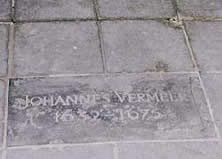
The burial records of the Delft Old Church indicate that Vermeer was buried on December 15, 1675. The once-prosperous painter left ten minor children and substantial debts to his wife, Catharina. In an effort to free herself from her creditors, she lamented the lack of financial resources, attributing it to her husband who had lapsed into "decay and decadence." The term "decadence" may have suggested that the artist had taken to drink, a common problem in the Netherlands, or perhaps experienced a sudden physical decline, such as a stroke or heart failure. Catharina stated that the artist had become so burdened by his financial troubles that "as if he had fallen into a frenzy, and in a day and a half had gone from being healthy to being dead." Although a tomb marker identifies Vermeer's grave in the Old Church, its original location has been lost over the centuries.
One of Vermeer's last paintings
According to Vermeer expert Walter Liedtke, the "similarities of this picture and in four late paintings by Vermeer might be taken as evidence of authenticity or imitation. Even the double shadow behind the music stand, the bluish-white illumination of the wall and its slight irregularities could be interpreted as extremely subtle derivations from late works by Vermeer, assuming the imitator had access to them and the expertise to imitate their unusual effects. However, technical analysis and conservation have revealed that the painting is at least 250 years old and that it was made from the ground up with materials and methods distinctive of Vermeer. The canvas is so consistent in its comparatively coarse weave with the support of The Lacemaker that they may be from the same bolt of cloth."
Furthermore, the orthogonals of the perspective all lead to a pinhole, a practical method employed repeatedly by Vermeer and other painters to work out and verify the perspectival construction. Perhaps the most convincing and peculiar piece of evidence in favor of the work's authenticity is the presence of natural ultramarine blue in minimal quantities in the gray paint mixture used to depict the background wall. This technique is unusual but not rare among upper-tier Dutch painters of the time.
Dating the painting
The most significant information regarding the possible dating of the present work was furnished by Marieke de Winkel, a costume expert for the Rembrandt Research Project. Based on research collected from a wide range of sources, including contemporary letters, prints, paintings and dollhouses, De Winkel established that the hairstyle and arrangement of the red ribbons were fashionable only for a couple of years at most, around 1670.
The combination of hair pulled back into a bun with ringlets hanging down on each side and a mix of thin red and white ribbons in the hair soon gave way in popular fashion to the style seen in the two London paintings. In those paintings, the hair is still drawn back into a bun but with numerous small decorative curls around the hairline and no ringlets or other embellishments. The Louvre Lacemaker, which is generally dated around 1670 on stylistic grounds, shows very much the same hairstyle as that seen here. This, together with the technical evidence linking the two pictures, suggests very strongly that the present painting of A Young Woman Seated at the Virginal should also be dated to around 1670, making it Vermeer's first exploration of the theme that would provide the subject for his two famous paintings in the National Gallery.
Nonetheless, this dating has been contested by the majority of Vermeer experts, such as Walter Liedtke, who hold that the picture is one of the artist's last, if not the very last, works.
The artist's final hardships

A Walking Musketeer Seen from Behind
Anthonie Palamedesz
1640s
Black chalk, brush and brown ink, 20.5 x 15.2 cm.
Metropolitan Museum of Art
Lest we judge too harshly the final works of Vermeer, it should be kept in mind that he must have painted very little in his final years. His life, like the lives of many, was plagued by social unrest and economic misfortune caused by the French invasion of the Netherlands in 1672, as well as an ever-growing family that proved increasingly difficult to provide for. Debt slowly closed in on Vermeer and his family, although until the end of his life, there is evidence that he was considered a respectable citizen. He was inscribed as a schutter, or marksman, of the Delft Civic Guard, a position that guaranteed a degree of honor and social standing.
In peacetime, acceptance in the militia required one to be "among the most learned burgers from the most admirable families and those who are men of property." However, in times of war, the entrance criteria could be stretched to include an occasional shoemaker and tailor. A guard's pay, compared to their duties, consisted of a small subsidy or a (partial) release from certain taxes, was negligible. Nevertheless, membership in a Civic Guard was a matter of civic pride, an honor that led to the development of a kind of "civic nobility" (burgeredeldom).
A final blow to Vermeer's fortune must have been the death of his long-time patron, Pieter van Ruijven, in 1674. Van Ruijven had acquired more than half of the artist's total output, assuring the artist an economic base that allowed him to paint as he wished, free from market pressures.
Recent critical acceptance
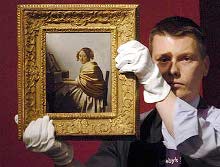
On March 30, 2004, Sotheby's announced the sale of A Young Woman Seated at the Virginals (not to be confused with the London painting of a similar theme and title) as an authentic painting by Johannes Vermeer. This small, unsigned canvas (about 25 x 20 centimeters) was first identified by modern collectors at an Amsterdam sale in 1814. Since 1960, it has been held in the private collection of Baron Freddy Rolin in Brussels, who passionately believed in the painting's authenticity. Even though the work never elicited more than a lukewarm critical response, experts such as Hofstede de Groot, Phillip Hale and P.T.A. Swillens had accepted it as an authentic Vermeer. Lawrence Gowing included only a photograph of it in his 1952 monograph but did not provide a comment about its artistic merits. In a later publication, he referred to it as a "melancholy relic."
The painting's fortune began to change when Walter Liedtke, curator of the comprehensive Vermeer and the Delft School show in New York and London (2001), decided at the very last minute to include it in that exhibition, even though it was not included in the catalogue.
After more than 10 years of extensive research by a team of leading scholars and painting conservators, the painting has now been proposed as a secure addition to Vermeer's limited oeuvre. Walter Liedtke included it within Vermeer's oeuvre in his 2008 complete catalog of Vermeer's paintings, and after years of doubt, Arthur K. Wheelock Jr. has come to accept it in the artist's slim oeuvre, although he believes it had been retouched in some areas.
Vermeer's limited fame
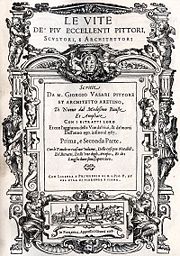
Although the figure of the isolated genius painter toiling away within the confines of his studio may be a central myth of modernism, it had little to do with earlier times. In his famous Vite, the artists that Giorgio Vasari admired are the same Renaissance artists we admire today, in nearly the same ranking and degree. Much the same could be said for the French, Dutch and Spanish schools.
Perhaps the greatest exception to this rule is Johannes Vermeer. Aside from a few celebrated works that held their own in the Netherlands, Vermeer's fame languished in near obscurity until the middle of the 19th century. He now keeps company with a handful of the greatest masters, such as Leonardo, Raphael and Rembrandt van Rijn.
Although Vermeer was admired in his own city, and his works commanded relatively high prices, his fame did not extend beyond Amsterdam. Ironically, the spread of his fame was substantially impaired by his own way of working and doing business. He painted slowly and produced very few works of art, no more than three or four a year. While 37 works have been proposed by authoritative scholars as authentic, there are good reasons to believe he probably painted no more than 60.
On the other hand, popular artists like Rembrandt van Rijn, Frans Hals and Jan van Goyen produced works in the hundreds; in van Goyen's case, more than one thousand paintings have survived. The output of Gabriel Metsu and Pieter de Hooch, Vermeer's direct "rivals," far exceeds Vermeer's.
More than half of Vermeer's works of art were purchased by a single local collector, Pieter van Ruijven and his wife Maria de Knuijt. In an age when there were neither public art galleries, museums, art publications, nor photographs, the distribution of a great number of paintings and/or graphic works was perhaps the best way to ensure that an artist's work would inscribe itself into the collective consciousness. Otherwise, to guarantee sufficient public exposure, works of art would have to have been exhibited in important public buildings or churches. This made widespread sales imperative in the Netherlands because it is well known that both public and religious patronage were in short supply in the United Republic.
Listen to period music
![]() Den Meij (The May), Anon. [997 KB]
Den Meij (The May), Anon. [997 KB]
performed by Hendrik Broekman
on a Flemish muselar virginal after Ruckers.
http://www.hubharp.com/sound_samples.htm
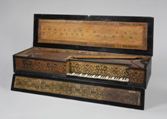
Together with the harpsichord the virginal (or virginals) has its origin in the medieval psaltery with a keyboard applied, to be able to play polyphonic music (i.e. melody with accompanying chords). It is mentioned for the first time c. 1460 in a treatise by Paulus Paulirinus of Prague. Although limited in its tonal resources, the virginal occupied a crucial position in the musical life in the 16th and 17th centuries as it was smaller, simpler and cheaper than the harpsichord.
The main center of virginal and keyboard making was Antwerp and Flanders, with the renowned families of Ruckers and Couchet. Italy was the second center, and after King Henry's VIII purchased five virginals it enjoyed considerable appreciation in England. Until the 18th century, the virginal remained in use both as a solo instrument, even in private circles of music making, as well as for accompaniment of the singing voice or melodic instruments, like the viola da gamba.
The virginal usually appears with a rectangular case, although polygon forms in various sizes were also built. The metal strings run roughly parallel to the keyboard. They are plucked by plectra mounted on jacks. The jacks (one for each key) are arranged in pairs and placed along a line running from the front of the instrument at the left to the back at the right. They pluck in opposite directions so that the pairs of jacks are separated by closely spaced pairs of strings. Each pair of jacks is usually served by a single slot in the soundboard, together with another slot below in a thin guide above the keys. Leather on the soundboard and lower guide provides a quiet bearing surface for the jacks.
The typical Flemish "muselar" type (probably invented by Hans Ruckers) has the keyboard to the right side, their strings plucked at a point near the center for virtually their entire range, producing a powerful, flute-like tone. Although the jacks and keys for the left hand are placed in the middle of the instrument's soundboard, any mechanical noise from these is amplified, and the central plucking point in the bass strings makes repetition difficult because the motion of the sounding string interferes with the ability of the plectrum to connect again. Thus, the muselar is better suited to chord- and melody-music without complex bass parts.
Muselars were popular in the 16th and 17th centuries and their ubiquity has been compared to that of the upright piano in the early 20th century, but like other types of virginals they fell out of use in the 18th century.
The virginal in Dutch interior painting

Husband and Wife of the Lossy de Wariné Family
Gerrit Donck
Oil on panel, 47.7 x 62.9 cm.
1631 (?)
Private collection
In Dutch interior painting, the virginal almost always conveys positive connotations of love and harmony. In the present work, which displays none of the elaborate iconographic dialogue of A Lady Seated at a Virginal and A Lady Standing at a Virginal, it is difficult to understand if the instrument can be truly understood as having symbolic meaning or if was nothing more than a straightforward sign of a young lady's musical inclination.
Although 90% of the virginals in 17th-century Dutch painting are pictured with women, they were included in more complex contexts such as Vermeer's Music Lesson and Gabriel Metsu's Man and Woman Sitting at the Virginal in which both men and women are present. In the Marriage Portrait of a Husband and Wife of the Lossy de Wariné Family by Gerrit Donck a finely crafted virginal, which rests on a rather unusual stand, occupies a notable part of the composition. Its conspicuous presence must have been intended to underscore the musical theme which apparently played an important part in bonding the lives of the husband and wife.
A portrait?


Following its inclusion in the complete catalogue of the artist's work by Walter Liedtke (2008), this minuscule canvas has attracted scarce critical scrutiny.
If the date currently given to this picture is correct, it was presumably executed shortly before or shortly after the A Lady Seated at a Virginal in London, in which a solitary woman plays her music in the corner of a dimly lit, contemporary room.
If one compares the present picture with a detail of the London picture, they appear closely related. In the smaller work, the young musician appears to be seated slightly further from her instrument while the forward side of her virginals is shrouded in deep shadow instead of being fully illuminated. From a compositional point of view either the present work was a sort of preliminary study for the more complex London work or, if executed afterward, a reworking of the figure.
In any case, the present work seems to be extraneous to Vermeer's customary manner of picture-making. It displays neither the elaborate iconographic structure of the artist's last works nor the frank simplicity of the bust-length tronies.
Liedtke has commented that it is conceivable that Vermeer was asked for a picture of the same themes as the Lady Seated at the Virginals in the years of economic hardship, "a time when any sale was welcome."
